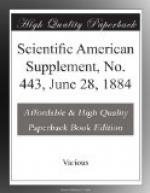The process of making oil is as follows: The fruit is crushed in a stone mill, generally moved by water power; the pulp is then put into bags made of fiber, and a certain number of these bags, piled one upon another, are placed in a press, most frequently worked by hand; when pressure is applied, the oil flows down into a channel by which it is conveyed to a receptacle or tank.
When oil ceases to flow, tepid water is poured upon the bags to carry off oil retained by the bags. The pulp is then removed from the bags, ground again in the mill, then replaced in the bags, and pressed a second time. The water used in the process of making oil must be quite pure; the mill, press, bags, and vessels sweet and clean, as the least taint would ruin the quality of the oil produced.
The oil which has collected in the tank or receptacle just mentioned is removed day by day, and the water also drained off, as oil would suffer in quality if left in contact with water; the water also, which necessarily contains some oil mingled with it, is sent to a deposit outside, and at some distance from the crushing house, which is called the “Inferno,” where it is allowed to accumulate, and the oil which comes to the surface is skimmed off from time to time. It is fit only for manufacturing purposes.
After the second pressing the olive-pulp is not yet done with; it is beaten up with water by mechanical agitators moved by water-power, and then the whole discharged into open-air tanks adjoining the crushing house. There the crushed olive kernels sink to the bottom, are gathered up and sold for fuel, fetching about 12 francs per 1,000 kilos, while the debris of the pulp is skimmed off the surface of the tank and again pressed in bags, yielding a considerable quantity of inferior oil, called “olio lavato,” or washed oil, which, if freshly made, is even used for food by the poorer classes. The pulp then remaining has still further use. It is sold for treatment in factories by the sulphide of carbon process, and by this method yields from seven to nine per cent. of oil, of course suitable only for manufacturing purposes. Only the first two pressings yield oil which ranks as first quality, subject of course to the condition of the fruit being unexceptionable. New oil is allowed to rest a while in order to get rid of sediment; it is then clarified by passing through clean cotton wool, when it is fit for use.
The highest quality of olive oil for eating purposes should not only be free from the least taint in taste or smell, but possessed of a delicate, appetizing flavor. When so many favorable conditions are needed as to growth, maturity, and soundness of the fruit, coupled with great attention during the process of oil-making, it is not to be wondered at that by no means all or even the greater part of the oil produced in the most favored districts of Tuscany is of the highest quality. On the contrary, the bulk is inferior and defective.




